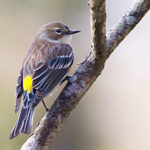 Wood warblers are among nature’s most spectacular creations, but often go unnoticed because of their retiring natures, dense leafy habitats and constant movement. Because they can vary a lot in plumage depending on their gender and the time of the year, wood warblers can also be challenging to identify.
Wood warblers are among nature’s most spectacular creations, but often go unnoticed because of their retiring natures, dense leafy habitats and constant movement. Because they can vary a lot in plumage depending on their gender and the time of the year, wood warblers can also be challenging to identify.
The strategy here is fundamentally the same as described in How to Really Learn the Birds. We’ll focus on a common local bird, study it in our bird book, then “target” the bird as we search for it in proper habitat. We’ll choose the most common warbler in our area; once we learn its various plumages we can use it as a “key” species to unlock the identities of other warblers.
In winter in the Northern San Joaquin Valley, only two warblers are common, and one of these, the Yellowthroat, is found only in or near wetlands. By far the most common warbler in our parks and gardens is the Yellow-rumped Warbler. Like most warblers, the males are brightly colored in spring and much drabber in winter. While some retain spring plumage longer than usual, the best way to locate the bird in fall and winter is to study the drab fall plumage, then go outside and look for the bright yellow rump that’s exposed when the birds fly or preen.
Because warblers are tiny and active, they offer the beginning birder a real challenge—they’re hard to keep an eye on, especially when trying to catch them in binoculars. The preferred method is to find the bird with the naked eye, focus on it, then tilt your binoculars gently up to your eyes. With practice, this method becomes second nature and enables the beginning birder to “get on” the bird rapidly.
Warblers are also challenging because the drab fall and winter plumages can be similar even among different species. This similarity poses a special problem with the Yellow-rumped Warbler because the group has been “split” into two distinct species, Audubon’s and Myrtle Warbler. So in addition to offering the opportunity to practice binocular skills, the Yellow-rumped Warbler also presents a living study guide for sharpening identification skills.
In essence, the fall and winter plumages of Audubon’s and Myrtle Warblers are the same. However, once you’ve honed your skills, you’ll notice the Myrtle Warbler has a distinct eye brow and dusky ear patch, both of which are lacking in the Audubon’s Warbler. Also, the white throat of the Myrtle Warbler, so distinctive in spring plumage, curves upward towards the ear patch, forming a noticeable comma shape on the Myrtle’s facial profile.
These two species in the Yellow-rumped Warbler group pose our most challenging problems so far as we learn our common Valley birds. They also offer some of our greatest rewards, because as winter turns to spring, the warblers will begin to “color up,” and we’ll see for ourselves why warblers are among veteran birders’ favorite birds. The bright spring plumages of Audubon’s and Myrtle Warblers are well worth waiting for and best appreciated after honing one’s identification skills on the drabber winter birds. Remember, study the fall and winter plumages in your bird guide, then look for these birds in the trees and shrubs nearby, including your own yard. Study them closely and when winter turns to spring you’ll be rewarded with one of nature’s most beautiful gifts.
